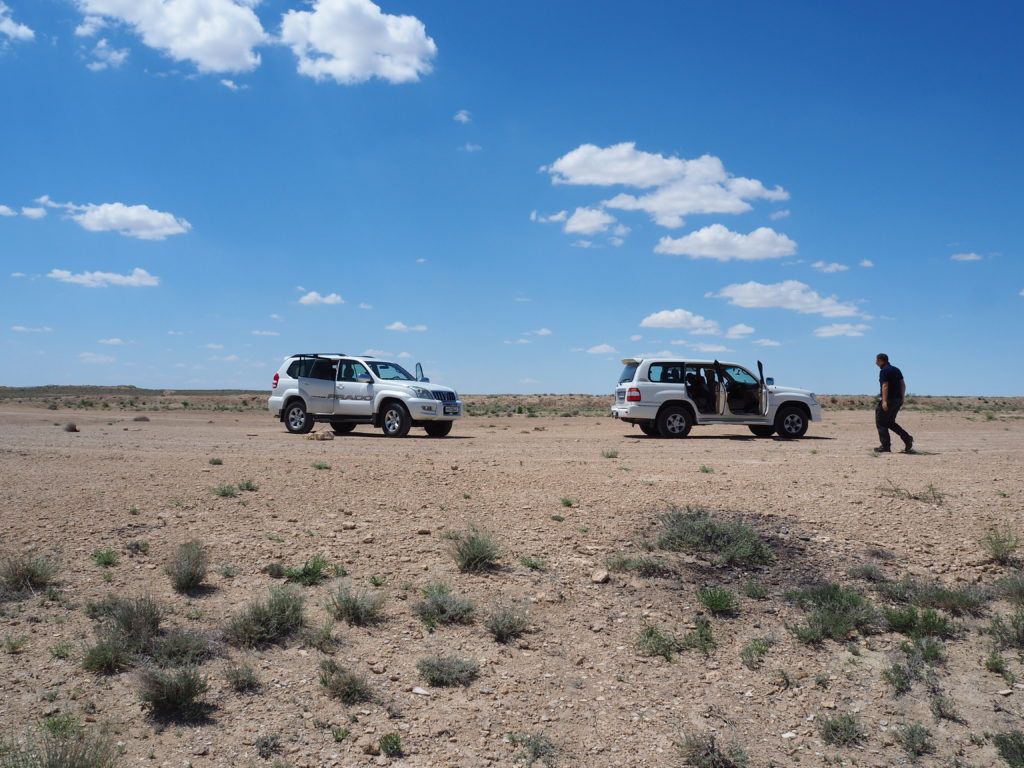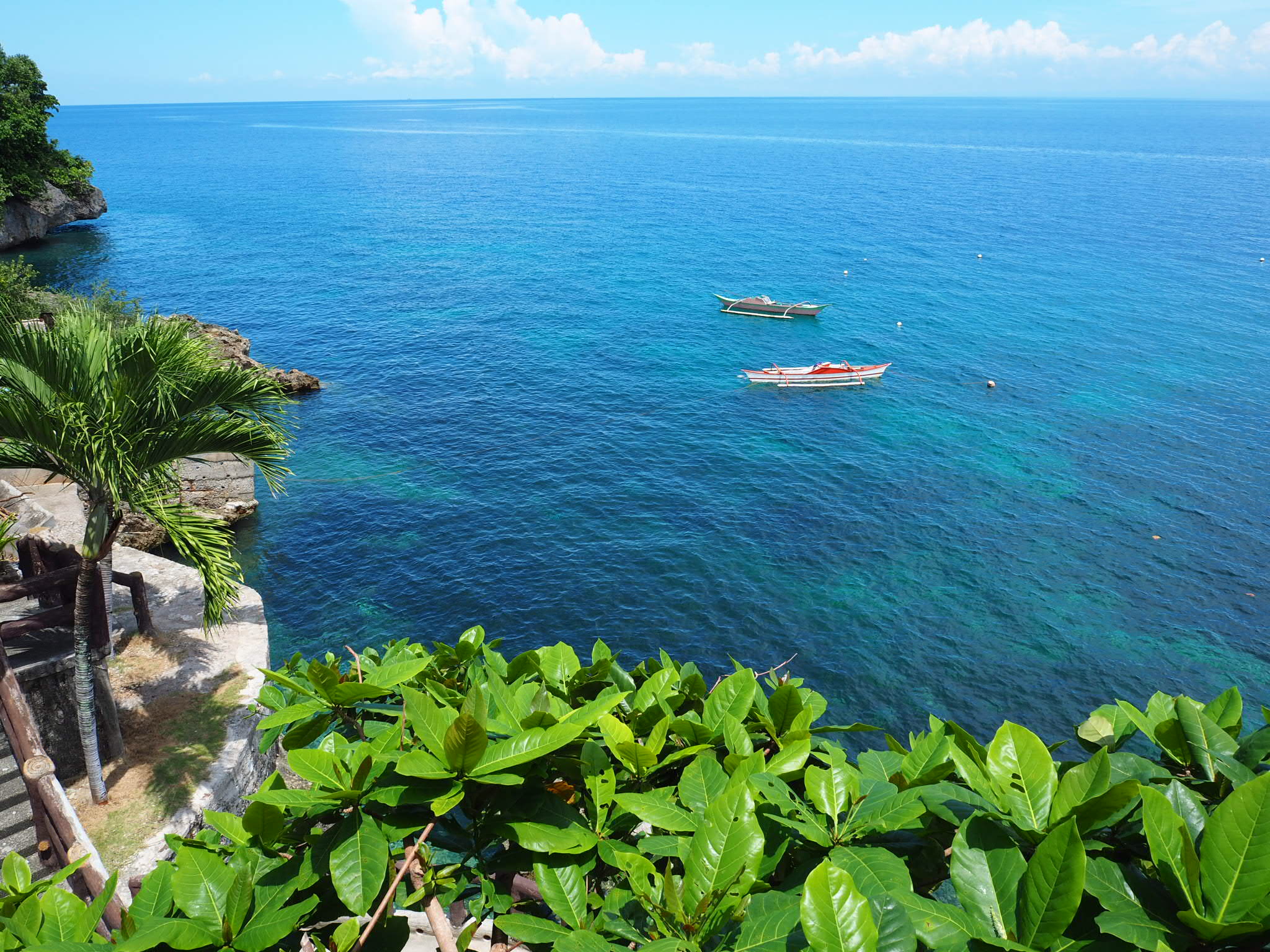Welcome to the Aral Sea
It has been called one of the greatest man made disasters in history. The Aral Sea was once the 4th largest lake in the world and home to a thriving fishing industry. An industry of such importance that it apparently provided all of the canned fish for the red army as they fought in World War 2. However it is now around 10% of its original size and the only evidence of a fishing industry is the rusting ships on seabed in Moynaq.
Getting to the Aral Sea is not easy. The nearest major town is the capital of Karakalpakstan, Nukus. A town of classic Soviet design, Nukus feels like the end of the line. Wide streets lined with buildings that hark back to the glory days of the Soviet Union. It is from here that all Aral Sea tours depart. Therefore getting to this far flung outpost is the first thing that you’ll need to arrange.
Most people come to Nukus by night train from Tashkent. There are daily trains leaving Tashkent south railway station at 6:20pm and arrive in Nukus just after 12pm. From Nukus station a taxi to Jipek Joli, which seems to the main hotel in Nukus, is around about 7000 som. We left Nukus and headed onto Khiva.
What to do in Nukus
Nukus is famous for the Savitsky museum of banned Soviet art. Smuggled out to Nukus by Igor Savitsky who wanted to find the last place anyone would possibly think to look. Sadly there is not a lot of English, so you don’t actually find out why the artwork was banned or about the artists who painted it.
Where we booked our tour
We booked our tour of the Aral Sea through Caravanistan. It is not cheap, as the only way to get out there is to hire a 4×4 with an experienced driver. However we certainly felt that the trip was value for money. In total we had 6 people and hired an English speak guide and it was $230 per person. Having an English speaking guide is something that we would definitely recommend. Our wonderful guide Ahmed, as well as speaking excellent English was able to provide a huge amount of information on Karakalpakstan, the Aral Sea and how the decline of the Aral Sea impacted the economy, environment and local psyche.
The tour that we purchased through Caravanistan covered our transportation, accomodation and almost all of our food (camels milk at Qubla Ustyurt was a treat we paid for ourselves). Entrance to Mizdahkan and Moynaq’s museums was not covered.
Getting to and from Nukus
Air
Uzbekistan Airlines operates regular flights from Tashkent to Nukus that cost around $60, probably more in peak season. From Nukus airport you will need to take taxi to the city centre itself.
Train
We took the night train from Tashkent to Nukus. Tickets can be purchased online or at various ticket offices in Tashkent. Check with your guesthouse or hostel as to where the nearest one is. You can also do the trip in reverse and take a night train from Nukus to Tashkent. Alternatively direct trains are also available to and from Smarkand. From our research it seems that there are no direct trains from Urgench or Bukhara at the time of writing. For some helpful information on the potential language barriers in Uzbekistan we have an article on the usefulness of Russian in Central Asia for you to check out.
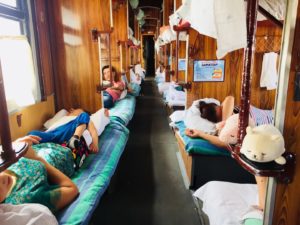
Shared Taxi
We took a shared taxi from Nukus to Khiva after returning from the Aral Sea. Due to the fact that they are unlikely to be able to pick people up for a return trip expect them to be more expensive than regular shared taxis in the country. We paid 200,000 som for a taxi, about 20 GBP for the 3 hour drive. The fees should be similar if going the other way from Khiva to to Nukus.
Where to stay
The main hotel in Nukus is Jipek Joli. They have 2 branches, both of which are very close to the Savitsky museum. Rooms are large and breakfast is included. The restaurant attached to the hotel serves standard Central Asia cuisine. This was the most expensive place we stayed in Uzbekistan.
Day 1
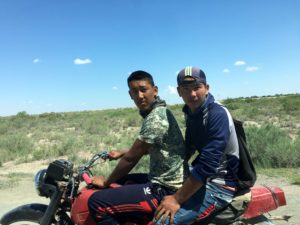
Mizdahkan
At 8 am we headed out of Nukus towards Mizdahkan, a collection of mausoleums. On the outside it is clear that the desert climate has taken its toll, however the insides have been wonderfully restored.
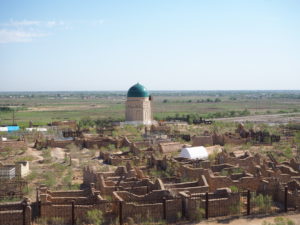
The Ustyurt Plateau
From here it was back into the 4x4s as we sped of towards Kungrad, the last town and last piece of paved road as we dived off into Kyzylkum desert. After driving into the desert we began to the climb onto the Ustyurt Plateau which gives incredible views over the desert. At many points you can see where the Aral Sea used to be. It’s quite hard to appreciate the sheer scale of the disaster. However by the time we reached our yurt camp on the fringes of what remains of the Aral Sea, the sheer amount that has been lost is truly staggering.
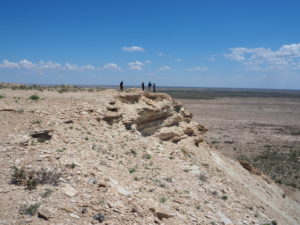
We took a break at the abandoned fishing village of Urga. The outer shells of the buildings where fish was sold and stored still remains, however the environment is slowly taking over.
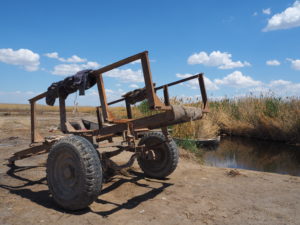
Qubla Ustyurt
We headed back up onto the plateau and pressed ahead to the tiny hamlet of Qubla Ustyurt. Located high up on the plateau this hamlet was created by the Soviet Government as base to conduct gas explorations in the area. The government relocate local nomads here to man the hamlet and support Soviet scientists in their quests for gas. Whilst there is apparently a small amount of gas still being extracted, there certainly doesn’t seem to be a huge amount of activity. Now the village is home to approximately 40 residents that make their living from farming and tourism alongside the gas. The villages largest, and possibly most impressive structure is the huge runway that was built for military and cargo planes to land on.
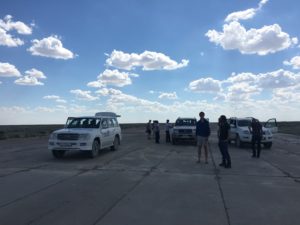
After sampling some camels milk, which I can only describe as tasting like carbonated yoghurt with the texture of slightly lumpy water, we headed for the main event; the Aral Sea. As we sped across the desert, we were surrounded by vast expanses of nothing. In every direction we saw the same thing; desert dotted with small shrubs. Somehow our drivers knew exactly where they were going.
Arriving at the Aral Sea
After kicking up sand for an hour or so we arrived on the edge of the Ustyurt plateau as it dropped dramatically towards to edge of the Aral Sea. Whenever the Aral Sea is mentioned it is usually in a negative light due to environmental, social and economic devastation it has wrought on the region. However standing on the edge of the plateau looking out over what remains, it is hard not be impressed.
From here is was down to the waters edge for a dip. The huge decline in size has left the body of water that remains incredibly salty. As a result you float like a cork as you enjoy the scenery around, but whatever you do, don’t get any water in your mouth.
The yurt camp that we stayed in has toilets and a hand pump shower. As well as wonderful views out over the Aral Sea. Our day ended with excellent Uzbek food washed down with a healthy amount of local vodka.
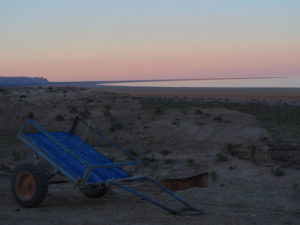
Day 2
Since you are looking east over the Aral Sea it is well worth getting up bright and early for sunrise.
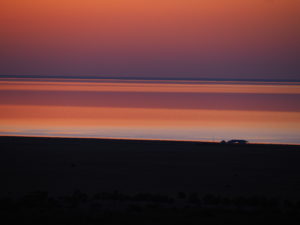
After breakfast we explored a nearby caravnserai before heading back up onto the plateau. We then headed for Moynaq, one of the most iconic locations in the former Soviet Union. To get to Moynaq we came down of the plateau and headed south east. It was here that we drove along a track that only 20 years or so ago was underwater. Now however, its a desolate desert landscape punctured by gas exploration companies hoping to strike it big.
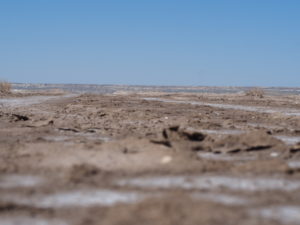
Seeing the reality and scale of the disaster here really hits home.
Moynaq’s Ship Graveyard
Moynaq is most famous for its ship graveyard. A bunch of ships left to rust in what used to be the harbour. This is probably one of the most iconic images of the former Soviet Union and most definitely of Uzbekistan itself.
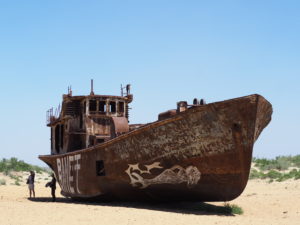
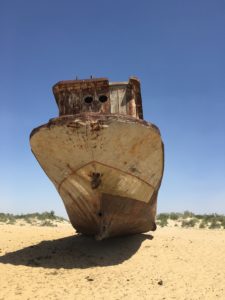
After arriving in Nukus 2 days earlier and feeling like we’d reached the very literal end of the line, Moynaq most definitely made us reconsider our feelings towards dear old Nukus. With unemployment hovering around 50% and a lot of unskilled jobs with the gas companies going to people who are not from Moynaq itself. Many people in this once prosperous town are struggling to eek out a living. We had a wonderful lunch with a local family, washed down with plenty of chai. From here it was a straight shot back to Nukus as the bleakness of the desert roared past us giving us plenty of time to contemplate the experience the last two days.
